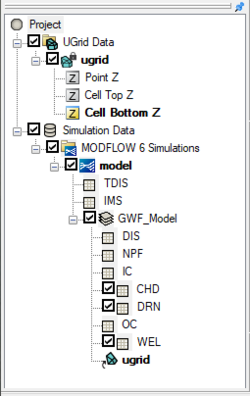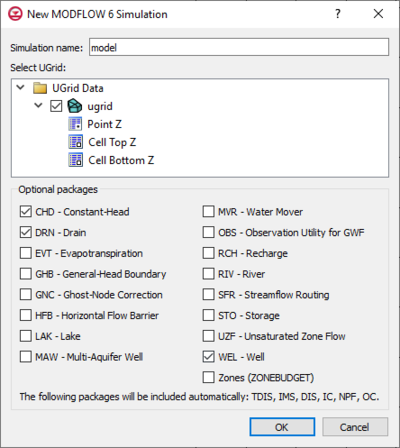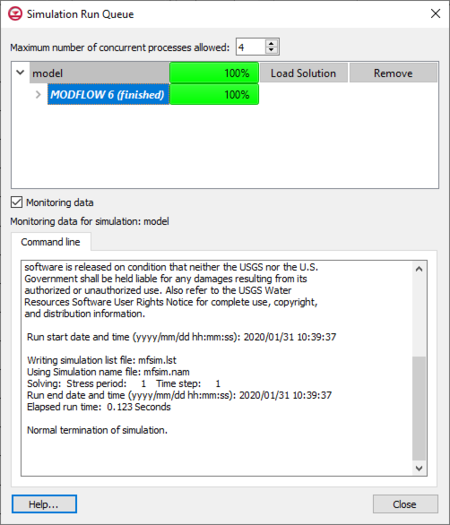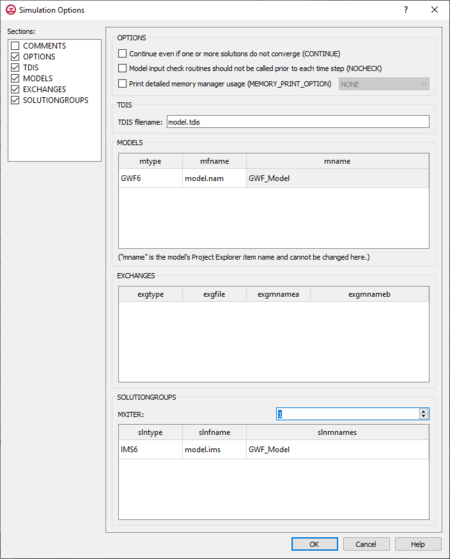User:Jcreer/MODFLOW 6
| This contains information about future features. |
| MODFLOW | |
|---|---|
| Pre-processing | |
| MODFLOW Commands | |
| Building a MODFLOW Model | |
| Map to MODFLOW | |
| Calibration | |
| Packages Supported in GMS | |
| Saving a MODFLOW Simulation | |
| Importing MODFLOW Files | |
| Unsupported MODFLOW Features | |
| Run MODFLOW | |
| Post-processing | |
| MODFLOW Display Options | |
| MODFLOW Post-Processing Viewing Options | |
| Reading a MODFLOW Simulation | |
| Tutorials | |
| Packages | |
| Flow: | BCF6, HUF, LPF, UPW |
| Solvers: | SMS |
| Other: | UZF1 |
Starting in GMS 10.5, GMS can create a basic MDOFLOW 6 project. Building a MODFLOW 6 project in GMS makes use of a simulation workflow. The new simulation workflow builds the MODFLOW 6 using a different procedure than previously used in GMS. This process allows for multiple MODFLOW 6 simulations to be contained in the same project file.
Contents
Building a MODFLOW 6 Simulation
Before building a MODFLOW 6 simulation, a 3D UGrid of the project area is required. While the project can contain multiple UGrids, only one UGrid can be attached to each MODFLOW 6 simulation.
To create a MODFLOW simulation:
- Right-click on an empty space in the Project Explorer, or right-click on "Project" in the Project Explorer, and select New Simulation | MODFLOW 6.
- In the New MODFLOW 6 Simulation dialog, select the UGrid for the simulation to use and select any optional packages needed for the simulation.
When the simulation has been initially created, the select UGrid will be linked to the simulation and the simulation packages will appear in the Project Explorer. Certain packages will always be included in the simulation. These include the TDIS and IMS packages along with the GWF model which includes the DIS, NPF, IC, and OC packages. Optional packages, if any were selected, will appear under the GWF model.
Double-clicking on any of the packages listed in the Project Explorer will bring up the package dialog for that package.
MODFLOW 6 Simulation Right-Click Menus
In the Project Explorer, right-clicking on MODFLOW 6 simulation brings up a menu with several commands. Some of these commands are common to other Project Explorer right-click menus. Others are unique to the simulation right-click menus. Some of these unique commands are:
- "Simulation Data"
- Simulation Run Queue – Opens the Simulation Run Queue dialog which shows all current simulation runs.
- "MODFLOW 6 Simulations"
- New Simulation – Creates a new MODFLOW 6 simulation in Project Explorer. This simulation will not contain any of the packages in any existing simulations and therefor the packages must be added. Also, creating a new simulation using this method requires linking a UGrid to the simulation.
- Simulation Run Queue – Opens the Simulation Run Queue dialog which shows all current simulation runs.
- Save All and Run – Saves all MODFLOW 6 simulations in the project and exports all files needed for the model run. It then will launch the Simulation Run Queu dialog and begin the model runs for all simulations in the project.
- Model
- Simulation Run Queue – Opens the Simulation Run Queue dialog which shows all current simulation runs.
- New Package – Opens a sub-menu listing all available packages that can be added to the simulation. Selecting a package will add it to the simulation. Some packages cannot be added until certain packages have already been added to the simulation and therefore will not be available until the prerequisite package has been added.
- Model Check – Checks the simulation for model errors and brings up the Model Check dialog if any errors are found.
- Save Simulation – Saves the simulation and exports all files needed for the model run.
- Run Simulation – Starts the simulation model run and opens the Simulation Run Queue dialog.
- Save Simulation and Run – Saves the simulation and exports all files needed for the model run. It then will launch the Simulation Run Queu dialog and begin the model runs for the simulation.
- Read Solution
New MODFLOW 6 Simulation Dialog
This dialog appears when a new MODFLOW 6 simulation is first created. The dialog has the following options:
- Simulation name – A name for the simulation can be entered in this field.
- Select UGrid – This section will contain a list of available UGrids to use in the MODFLOW 6 simulation. A UGrid must be selected before the simulation can be created.
- Optional packages – This seciton contains a list of avaialble optional packages that be included when the simulation is created. A message at the bottom of this section will state which packages are already included in the simulation being created.
Simulation Run Queue
The Simulation Run Queue is used to manage multiple simulations. Once a simulation is started, the Simulation Run Queue appears. The dialog can also be reached by right-clicking on a simulation item in the Project Explorer and selecting the Simulation Run Queue command.
The number of processes allowed in the run queue is determined by the following option:
- Maximum Number of Concurrent Processes Allowed – Determines how many processes can be active in GMS at the same time. A simulation may contain multiple processes.
The run queue will show all simulations that are either currently running or have not yet been removed from the run queue. Each simulation will be listed in the order the simulation runs were started. Each simulation can be expanded to show what happened during the model run. If the model has a pre-processor and/or a post-processor, these will be displayed separately from the main model run. Process bars display how much of the process have been completed.
The following actions can be taken for each simulation:
- Load – Loads the solution files into SMS from a completed simulation run.
- Abort – Ends a simulation run before it has completed.
- Remove – Deletes a completed or aborted simulation from the run queue.
Towards the bottom of the dialog, the following is displayed:
- Command Line – Shows the results of the command line model run for the selected simulation.
Simulation Options Dialog
Exporting MODFLOW 6 Files
Starting in GMS 10.4, GMS can export MODFLOW files for use with MODFLOW 6. This version of MODFLOW contains a new object-oriented program and underlying framework for supporting multiple types of models within the same simulation.
The process for doing this is similar to that of saving native text files. In the MODFLOW Global/Basic Package dialog, there is an option to Save MODFLOW 6 copy. When this option is selected, MODFLOW 6 files will be generated when running MODFLOW from GMS.
Unsupported Features
The MODFLOW 6 export option does not function with projects that are incompatible with MODFLOW 6. Projects with unsupported features or parameters will not be successfully exported.
Not all MODFLOW packages are supported in MODFLOW 6. The following table shows the correlation between MODFLOW 6 packages and packages from previous versions of MODFLOW.
| MODFLOW 6 supported packages | Equivalent Mf2k5/USG package |
|---|---|
| CHD, DRN, GHB, RIV, WEL | CHD, DRN, GHB, RIV, WEL |
| DIS, DISV, DISU, TDIS | DIS, DISU |
| EVT, RCH | EVT, ETS, RCH |
| GNC | GNC |
| IC | BAS |
| LAK | LAK |
| MAW | MNW2 |
| NPF, STO | BCF, HUF, LPF, UPW |
| SFR | SFR |
| UZF | UZF |
| MVR, GWF, OBS | Not supported |
| Not Supported | DRT, GAGE, MNW1, MNWI, STR, SUB, SWI, OBS, HOB, CHOB, RVOB, STOB, DROB |
MODFLOW 6 Files
The files generated for MODFLOW 6 will appear similar to those created for other versions of MODFLOW. The *.mfn.log file will contain notes about the export and mention any items that could not be exported for MODFLOW 6.
For more details, see the MODFLOW 6 Input and Output document
External Link
| GMS – Groundwater Modeling System | ||
|---|---|---|
| Modules: | 2D Grid • 2D Mesh • 2D Scatter Point • 3D Grid • 3D Mesh • 3D Scatter Point • Boreholes • GIS • Map • Solid • TINs • UGrids | |
| Models: | FEFLOW • FEMWATER • HydroGeoSphere • MODAEM • MODFLOW • MODPATH • mod-PATH3DU • MT3DMS • MT3D-USGS • PEST • PHT3D • RT3D • SEAM3D • SEAWAT • SEEP2D • T-PROGS • ZONEBUDGET | |
| Aquaveo | ||



